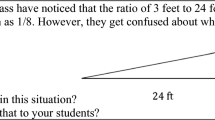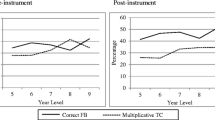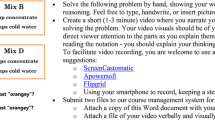Abstract
Teachers’ knowledge of proportional reasoning is important, particularly in the middle grades in the USA. This exploratory study investigated 32 teachers’ use of knowledge resources in two mathematically similar tasks (one a paper and pencil task, the other a dynamic task) around proportional reasoning. The two tasks invoked different knowledge resources by the same teachers. Results suggest questions to the field around how we access or invoke teacher knowledge and the need to more purposefully explore the potential benefits of using a dynamic task to invoke knowledge resources.



Similar content being viewed by others
References
Akar, G. (2010). Different levels of reasoning in within state ratio conception and the conceptualization of rate: a possible example. In P. Brosnan, D. B. Erchick, & L. Flevares (Eds.), Proceedings of the 32nd annual meeting of the North American Chapter of the International Group for the Psychology of Mathematics Education (Vol. 4, pp. 711–719). Columbus: The University of Ohio.
Battista, M. T. (2008). Representations and cognitive objects in modern school geometry. In M. K. Heid & G. W. Blume (Eds.), Research on technology and the teaching and learning of mathematics: Cases, and perspectives Volume 2. (pp. 341–362). Charlotte: Information Age Publishing, Inc.
Bell, L., Juersivich, N., Hammond, T. C., & Bell, R. L. (2012). The TPACK of dynamic representations. In R. Ronau, C. Rakes, & M. Niess (Eds.), Educational technology, teacher knowledge, and classroom impact (pp. 103–135). Hershey, PA: IGI Global.
Berk, D., Taber, S. B., Gorowara, C. C., & Poetzl, C. (2009). Developing prospective elementary teachers’ flexibility in the domain of proportional reasoning. Mathematical Thinking and Learning, 11(3), 113–135.
Bezuk, N., Bay-Williams, J., Clements, D. H., Martin, W. G., Aguirre, J., Boerst, T., et al. (2017). AMTE standards for mathematics teacher preparation.
Brown, R.E., Weiland, T. & Orrill, C.H. (2020). Mathematics Teachers’ Use of Knowledge Resources When Identifying Proportional Reasoning Situations. International Journal of Science and Mathematics Education 18, 1085–1104. https://doi.org/10.1007/s10763-019-10006-3
Charmaz, K. (2014). Constructing grounded theory (2nd ed.). Thousand Oaks: Sage Publications Ltd..
de Bock, D., Van Dooren, W., Janssens, D., & Verschaffel, L. (2002). Improper use of linear reasoning: an in-depth study of the nature and the irresistibility of secondary school students’ errors. Educational Studies in Mathematics, 50(3), 311–334.
diSessa, A. A. (1988). Knowledge in pieces. In G. Forman & P. Pufall (Eds.), Constructivism in the computer age (pp. 49–70). Hillsdale: Lawrence Erlbaum Associates, Inc..
diSessa, A. A., Sherin, B. L., & Levin, M. (2016). Knowledge analysis: an introduction. In A. A. diSessa, M. Levin, & N. J. S. Brown (Eds.), Knowledge and interaction: a synthetic agenda for the learning sciences (pp. 30–71). New York: Routledge.
Gagatsis, A., & Shiakalli, M. (2004). Ability to translate from one representation of the concept of function to another and mathematical problem solving. Educational Psychology, 24(5), 645–657.
Goldin, G. A. (2014). Mathematical representations. In S. Lerman (Ed.), Encyclopedia of mathematics education (pp. 409–413). Dordrecht: Springer Netherlands.
Harel, G., & Behr, M. (1995). Teachers’ solutions for multiplicative problems. Hiroshima Journal of Mathematics Education, 3, 31–51.
Hitt, F. (2002). Representations and mathematics visualization (Papers presented in the working group of the same name at PME-NA, 1998–2002). Mexico City: Cinvestav-Ipn.
Izsák, A., & Jacobson, E. (2017). Preservice teachers’ reasoning about relationships that are and are not proportional: a knowledge-in-pieces account. Journal for Research in Mathematics Education, 48(3), 300–339.
Lamon, S. (2007). Rational numbers and proportional reasoning: toward a theoretical framework for research. In F. K. Lester (Ed.), Second handbook of research on mathematics teaching and learning (pp. 629–667). Reston, VA: National Council of Teachers of Mathematics.
Lesh, R., Post, T., & Behr, M. (1987). Representations and translations among representations in mathematics learning and problem solving. In C. Janvier (Ed.), Problems on representation in the teaching and learning of mathematics (pp. 33–40). Hillsdale, NJ: Lawrence Erlbaum Associates.
Lobato, J., & Ellis, A. (2010). Developing essential understanding of ratios, proportions & proportional reasoning: grades 6–8. Reston, VA: National Council of Teachers of Mathematics.
Lobato, J., Orrill, C. H., Druken, B., & Jacobson, E. (2011, April). Middle school teacher’s knowledge of proportional reasoning for teaching. Paper presented as part of J. Lobato (chair), Extending, expanding, and applying the construct of mathematical knowledge or teaching (MKT). Annual Meeting of the American Educational Research Association, New Orleans.
Marrades, R., & Gutiérrez, Á. (2000). Proofs produced by secondary school students learning geometry in a dynamic computer environment. Educational Studies in Mathematics, 44(1–2), 87–125.
Modestou, M., & Gagatsis, A. (2007). Students’ improper proportional reasoning: a result of the epistemological obstacle of “linearity”. Educational Psychology, 27(1), 75–92.
Modestou, M., & Gagatsis, A. (2010). Cognitive and metacognitive aspects of proportional reasoning. Mathematical Thinking and Learning, 12(1), 36-53. https://doi.org/10.1080/10986060903465822
Nagar, G. G. (2019). Conceptualization of and reasoning about mathematical structures: Variance and invariance in a dynamic geometry environment [doctoral dissertation]. University of Massachusetts Dartmouth.
National Council of Teachers of Mathematics. (2000). Principles and standards for school mathematics. Reston, VA: National Council of Teachers of Mathematics, Inc..
National Council of Teachers of Mathematics (NCTM). (2014). Principles to actions: ensuring mathematical success for all. Reston, VA: Author.
National Governors Association Center for Best Practices [NGA Center], & Council of Chief State School Officers [CCSSO]. (2010). Common core state standards for mathematics. Washington DC: Authors. Retrieved April 27, 2017, from http://www.corestandards.org/assets/CCSSI_Math%20Standards.pdf.
Orrill, C. H., Brown, R. E., Nagar, G. G., Millett, J., Park, J., & Burke, J. P. (2017, October). Extending appropriateness: Further exploration of teachers’ knowledge resources for proportional reasoning. In E. Galindo, & J. Newton (Eds.), Proceedings of the 39th annual meeting of the North American Chapter of the International Group for the Psychology of Mathematics Education (pp. 581-588). Indianapolis, IN: Hoosier Association of Mathematics Teacher Educators.
Orrill, C. H., Burke, J. P., Millett, J. E., & Park, J. F. (2018, April). Proportions playground: Using interactivity to support mathematical reasoning. Presented as part of A. Busey & C. McCulloch (Chairs), Advancing online and blended professional development through NSF’s DRK-12 program. Structured poster session presented at the Annual Meeting of the American Educational Research Association, New York.
Post, T., Harel, G., Behr, M., & Lesh, R. (1988). Intermediate teacher’s knowledge of rational number concepts. In Fennema et al. (Ed.), Papers from First Wisconsin symposium for research on teaching and learning mathematics (pp. 194–219). Madison, WI: Wisconsin Center for Education Research.
Presmeg, N. C. (2006). Research on visualization in learning and teaching mathematics. In A. Gutierrez & P. Boero (Eds.), Handbook of research on the psychology of mathematics education: past, present and future (pp. 205–235). Rotterdam: Sense Publisher.
Riley, K. R. (2010). Teachers’ understanding of proportional reasoning. In P. Brosnan, D. B. Erchick, & L. Flevares (Eds.), Proceedings of the 32nd annual meeting of the North American Chapter of the International Group for the Psychology of Mathematics Education (Vol. 6, pp. 1055–1061). Columbus, OH: The Ohio State University.
Russo, J., & Russo, T. (2020). Movies through a mathematical lens. Australian Primary Mathematics Classroom, 25(1), 20–26.
Sedig, K., & Liang, H. N. (2006). Interactivity of visual mathematical representations: factors affecting learning and cognitive processes. Journal of Interactive Learning Research, 17(2), 179.
Siegler, R., Carpenter, T., Fennell, F., Geary, D., Lewis, J., Okamoto, Y., Thompson, L., & Wray, J. (2010). Developing effective fractions instruction for kindergarten through 8th grade: a practice guide (NCEE #2010–4039). Washington, DC: National Center for Education Evaluation and Regional Assistance, Institute of Education Sciences, U.S. Department of Education. Retrieved June 15, 2020, from www.whatworks.ed.gov/publications/practiceguides.
Stavy, R., & Tirosh, D. (2000). How students (mis)-understand science and mathematics: intuitive rules. New York: Teachers College Press.
Stein, M. K., Grover, B. W., & Henningsen, M. (1996). Building student capacity for mathematical thinking and reasoning: an analysis of mathematical tasks used in reform classrooms. American Educational Research Journal, 33(2), 455–488.
Stein, M. K., Smith, M. S., Henningsen, M., & Silver, E. A. (2000). Implementing standards-based mathematics instruction: a casebook for professional development. New York: Teachers College Press.
Van Dooren, W., De Bock, D., Hessels, A., Janssens, D., & Verschaffel, L. (2005). Not everything is proportional: effects of age and problem type on propensities for overgeneralization. Cognition and Instruction, 23(1), 57–86.
Van Dooren, W., De Bock, D., Janssens, D., & Verschaffel, L. (2008). The linear imperative: an inventory and conceptual analysis of students’ overuse of linearity. Journal for Research in Mathematics Education, 39(3), 311–342.
Vergnaud, G. (1983). Multiplicative structures. In R. Lesh & M. Landau (Eds.), Acquisition of mathematics concepts and processes. Academic Press.
Weiland, T., Orrill, C. H., Brown, R. E., & Nagar, G. G. (2019). Mathematics teachers’ ability to identify situations appropriate for proportional reasoning. Research in Mathematics Education, 21(3), 233-250. doi: 10.1080/14794802.2019.1579668
Weiland, T., Orrill, C. H., Nagar, G. G., Brown, R. E., & Burke, J. (2020). Framing a robust understanding of proportional reasoning for teachers. Journal of Mathematics Teacher Education. https://doi.org/10.1007/s10857-019-09453-0
Zbiek, R. M., Heid, M. K., & Blume, G. W. (2007). Research on technology in mathematics education. In F. K. Lester (Ed.), Second handbook of research on mathematics teaching and learning (pp. 1169–1207). Charlotte, NC: Information Age Pub.
Acknowledgments
The authors would like to thank Travis Weiland, James Burke, and Gili Nagar for their support in data collection and analysis.
Funding
The work reported here was supported by the National Science Foundation under grants DRL-1621290 and DRL-1054170.
Author information
Authors and Affiliations
Corresponding author
Ethics declarations
Disclaimer
Any opinions, findings, and conclusions or recommendations expressed in this material are those of the author(s) and do not necessarily reflect the views of the National Science Foundation.
Conflict of interest
The authors declare that they have no conflict of interest.
Additional information
Publisher’s note
Springer Nature remains neutral with regard to jurisdictional claims in published maps and institutional affiliations.
Rights and permissions
About this article
Cite this article
Brown, R.E., Orrill, C.H. & Park, J. Exploring differences in practicing teachers’ knowledge use in a dynamic and static proportional task. Math Ed Res J 34, 419–436 (2022). https://doi.org/10.1007/s13394-020-00350-x
Received:
Revised:
Accepted:
Published:
Issue Date:
DOI: https://doi.org/10.1007/s13394-020-00350-x




